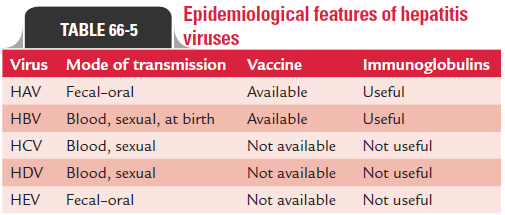Chapter: Microbiology and Immunology: Virology, Virus: Arboviruses
Hepatitis E Virus
Hepatitis E Virus
Hepatitis E virus (HEV) is the primary cause of enterically transmitted non-A non-B hepatitis virus (NANBH), most commonly seen in developing countries including India. The virus has many similarities with HAV. The virus was first observed during the electron microscopy of feces contaminated with enteric NANBH.
Hepatitis E virus is currently classified in the family Calciviridae. It resembles calciviruses, such as Norwalk virus. However, the HEV genome is different from genome of other calciviruses, and analysis of the genome sequence suggests that it is more similar to rubella virus. Therefore, HEV still remains to be classified.
It is a nonenveloped, spherical virus measuring 32–34 nm in diameter. The surface of the virion shows indentations and spikes. It is icosahedral. The virus contains a positive-sense single-stranded RNA, approximately 7.6 kb in size. The viral genome contains three open reading frames (ORFs). ORF1 is the largest, which codes for nonstructural protein responsible for viral repli-cation. ORF2 encodes for the capsule. The function of ORF3 is not known. The virus is heat stable. The cloning of viral genome showed HEV to consist of only one serotype. In HEV infection, the IgM antibody titer appears first, which falls rapidly after infec-tion, becoming virtually undetectable within 6 months. Anti-HEV IgG, however, persist longer for more than 6 months. The IgG antibody appears to offer protection against reinfection by HEV.
Hepatitis E virus usually causes an acute, self-limiting disease similar to HAV. Earlier it was mistaken for HAV due to clinical and epidemiological similarity. Hepatitis E virus infection, now, has been recognized as a distinct clinical entity, different from the infection caused by HAV. Clinically, HEV infection differs from HAV infection by causing acute disease and by the occur-rence of symptoms much later than those of HAV disease.
The incubation period of HEV infection varies from 2 to 9 weeks with an average of 35 days.
Hepatitis E virus causes a serious infection in pregnant women. It causes fulminant disease in pregnant women, especially in last trimester of pregnancy and has a high fatality rate of 15–20%. Encephalopathy and disseminated intravascular coagulation are the important causes of death. The rate of ful-minant hepatic failure in infected pregnant women is very high.
Hepatitis E virus infection does not appear to cause chronic liver diseases.
Infiltration of portal tract by lymphocytes and polymorpho-nuclear leukocytes, balloon hepatocytes, formation of acidophilic bodies, and intralobular necrosis of hepatocytes is the classic pathological finding of HEV infection.
Hepatitis E virus is distributed worldwide. It is most commonly found in developing countries. The epidemics of HEV have been recorded in India, Pakistan, Nepal, China, Burma, North Africa, and Mexico. During 1986–1988, one such large outbreak was reported in north-east China affecting nearly 10,000 people.
In India, the largest epidemic of HEV occurred in Delhi during the winter of 1955–1956, affecting more than 30,000 persons. Anti-HEV antibodies are observed in serum of as many as 60% of children in India below 5 years of age. Tropical cli-mate, poor sanitation, and poor personal hygiene all contribute to the epidemic of the disease in developing countries.
Hepatitis E virus is transmitted primarily by fecal–oral route due to fecal contamination of water in endemic areas. Fecal contaminated water is the important source of infection. The reservoir of HEV is unknown, but it may be transmitted by animals.

Treatment of HEV infection is mainly supportive. No vaccine is available now for prevention of HEV. Administration of immunoglobulin does not prevent development of clinical disease. Hepatitis E virus infections respond poorly to treatment with serum IgG. Epidemiological features of hepati-tis viruses are summarized in Table 66-5.
Related Topics